Astronomers Observe Disintegrating Comet ATLAS | Astronomy – Sci-News.com
Using the NASA/ESA Hubble Space Telescope and several ground-based telescopes, astronomers have been able to watch the long-period comet C/2019 Y4 (ATLAS) as it broke up into four large fragments.
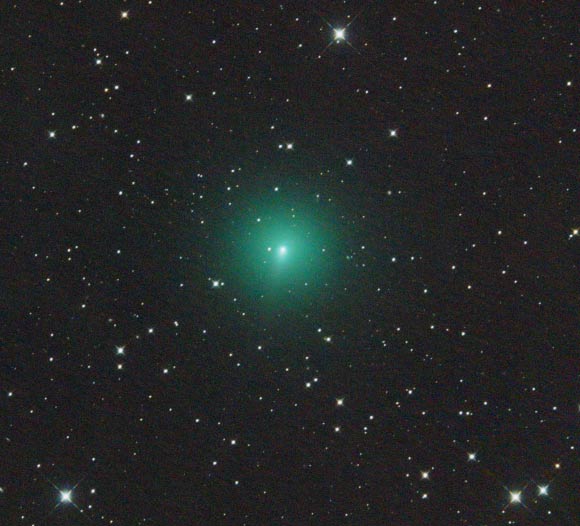
This image of C/2019 Y4 (ATLAS) was captured on March 14, 2020. Image credit: Martin Gembec / CC BY-SA 4.0.
C/2019 Y4 (ATLAS) is a comet with a near-parabolic orbit and an orbital period of about 6,000 years.
Also known as comet ATLAS, the object was discovered on December 28, 2019 by a reflecting telescope atop Mauna Loa in Hawaii as part of the Asteroid Terrestrial-impact Last Alert System (ATLAS).
At the time of its discovery, the comet was about 3 AU from the Sun and shone at magnitude of 19.6 in the constellation of Ursa Major.
In April 2020, it moved into Camelopardalis, and next month it will move into the constellation of Perseus.
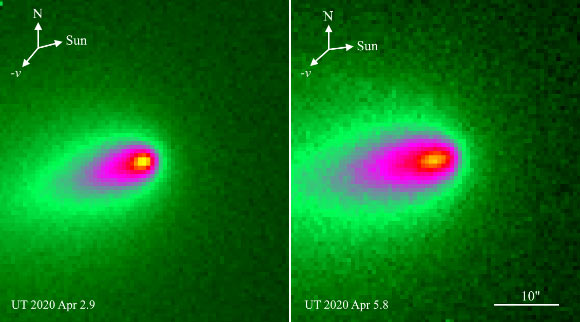
These images of C/2019 Y4 (ATLAS) were captured on April 2 and 5, 2020. Image credit: Quanzhi Ye & Qicheng Zhang.
On April 6, University of Maryland astronomer Quanzhi Ye and Caltech astronomer Qicheng Zhang reported on the possible disintegration of comet ATLAS.
“Images taken on April 5 from the 0.6-m Ningbo Education Xinjiang Telescope (NEXT) showed an elongated pseudo-nucleus measuring about 3 arcsec in length and aligned with the axis of the tail, a morphology consistent with a sudden decline or cessation of dust production, as would be expected from a major disruption of the nucleus,” they wrote in the Astronomer’s Telegram.
“A disruption event could also potentially explain the large non-gravitational forces acting on the comet.”
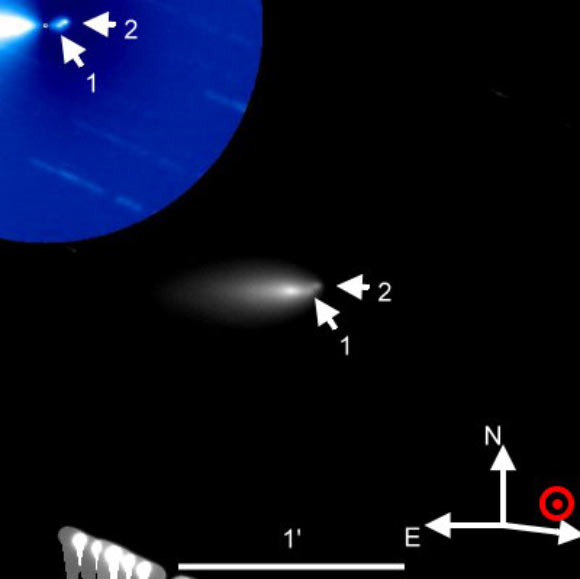
This image from the Lulin 1-m telescope shows at least two fragments of C/2019 Y4 (ATLAS). The separation distance between nucleus and 1 is about 3,400 km and that of fragments 1 and 2 is about 1,600 km. Image credit: Lin et al.
Images captured on April 12 by the 1-m telescope at Lulin Observatory, Taiwan, showed the presence of at least two fragments of the comet.
On April 18, a large team of astronomers confirmed that the comet fragmented into several pieces, designated A to D.
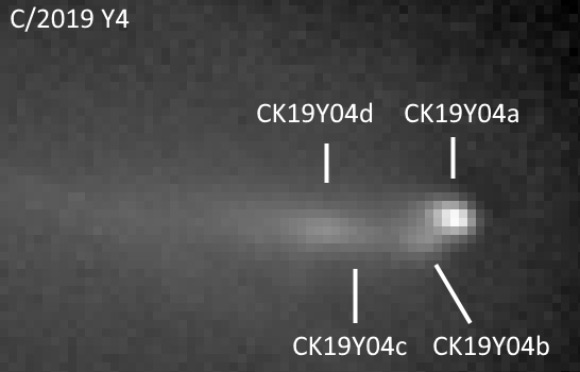
This image, taken on April 13, 2020, shows the relative position of four fragments of C/2019 Y4 (ATLAS). Image credit: P. Birtwhistle.
“Images taken during the past week display clear evidence of the fragmentation of the comet,” they said.
“Greater than expected astrometric residuals, with respect to the computed orbit of the comet, also suggest unusual activity in the nucleus and significant non-gravitational forces acting over the past several weeks.”
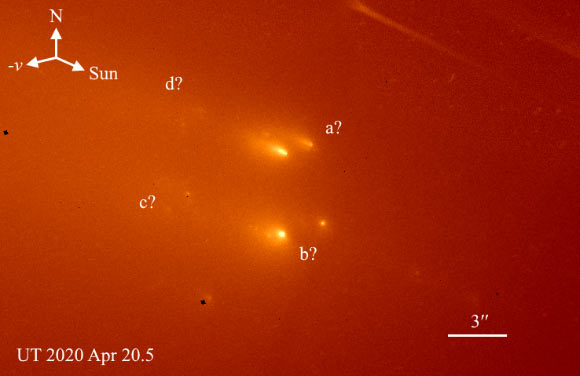
This image, taken on April 20, 2020, shows fragments of C/2019 Y4 (ATLAS). Image credit: Quanzhi Ye & Man-To Hui.
University of Maryland’s Dr. Ye and University of Hawaii’s Dr. Man-To Hui then used Hubble to observe fragments of comet ATLAS.
“Single-epoch observation with Hubble on April 20 showed only two remaining major fragments, likely A and B, each consists of 1 to 2 brighter components and a couple more fainter components, situated 4 arcsec from each other along their common orbit,” they said.
“Fragments C and D seem to have been reduced into a handful of fainter fragments.”
“At the time of the observation, the comet was at a heliocentric distance of 1.10 AU and a geocentric distance of 0.98 AU.”
_____
Quanzhi Ye & Qicheng Zhang. 2020. Possible Disintegration of Comet C/2019 Y4 (ATLAS). ATel #13620;
Zhong-Yi Lin et al. 2020. The Fragmentation of Comet C/2019 Y4 (ATLAS) observed at Lulin observatory. ATel #13629
I. Eglitis et al. COMET C/2019 Y4 (ATLAS). MPEC 2020-H28
Quanzhi Ye & Man-To Hui. 2020. Continuing Fragmentation of C/2019 Y4 (ATLAS). ATel #13651






